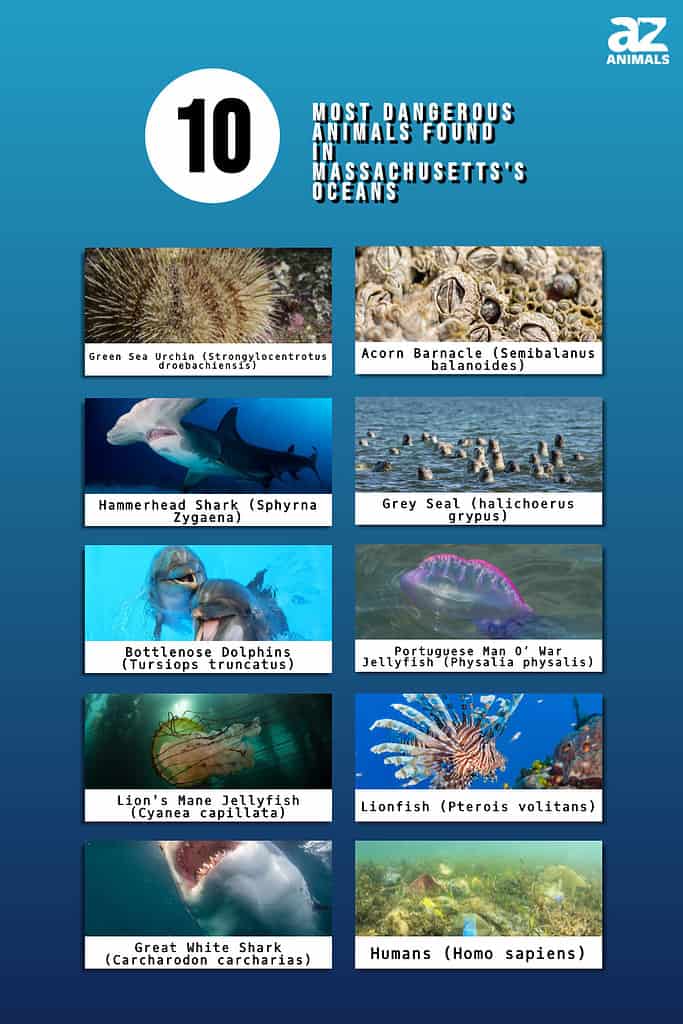
Whether you live at the beach, are planning a move there, or are just visiting the Massachusetts coast, taking note of the dangers around you is always wise. The northeastern beaches are colder than others and offer a unique way to view seals. Of course, Martha’s Vineyard is where the movie Jaws was filmed, and nobody has viewed the ocean the same since.
Sharks are far from the most dangerous animal that can harm you while visiting Cape Cod. Unfortunately, you probably won’t see any lovely mermaids, as seen in the movie, Splash, so be sure not to fall off any boats.
It is safe to say that where you see seals, you should not swim. Sharks do not want to eat us because we do not taste like seals. Most shark attacks are due to sharks mistaking us for tastier food, like large fish or seals. They do not have excellent vision and tend to take a test bite out of things to discover what they are and if they’re tasty. If you don’t want to encounter sharks or any of the other nine dangerous animals in this article, stay out of the ocean along the Massachusetts coast. Of course, land, air, and freshwater bodies of water all have their own dangers.
1. Green Sea Urchin (Strongylocentrotus droebachiensis)

Stepping on a
sea urchin
can be one of the worst times in your life.
©NatureDiver/Shutterstock.com
Appearance: Ping pong ball or larger-sized oceanic quill cushions
Size: Up to 3.5 inches
Where to Avoid: Shallow tide pools where stepping on one would be easy
Unpleasant Symptoms: The pedicellariae or spines can break off in the skin leaving black and blue bruising. The pedicellariae cause severe pain and infection and often requires surgery.
Side Effects: Severe pain and broken quills that travel to organs can cause nausea, vomiting, paresthesias, weakness, abdominal pain, syncope, hypotension, and respiratory distress.
Sea Urchins are called sea hedgehogs because of their ball-of-quills appearance, similar to that of a hedgehog when it’s curled up. Also, the term “urchin” is derived from the French word for hedgehog, “yrichon.” These little spike balls can live up to 25 years in the tide pool. They tend to live among rocky substrate in fairly shallow water along the Massachusetts coast, where it would be easy to step on one. They can, however, live up to 1150 feet beneath the ocean’s surface.
2. Acorn Barnacle (Semibalanus balanoides)
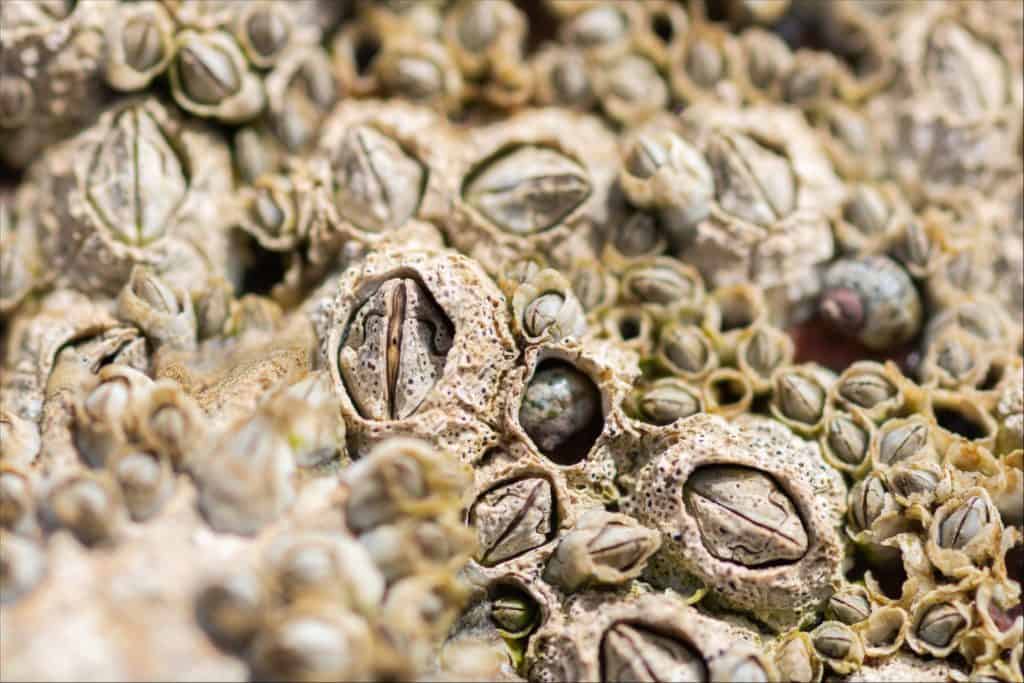
A group of goose barnacles with seashells, attached to a wooden log on the Massachusetts coast, might not pose a threat, but stepping on them when submerged in the ocean can end with stitches.
©Alexisaj/Shutterstock.com
Appearance: Comparable with dinosaur toes, they are a few inches long inside of this armor and are like shrimp or mollusks.
Size: Up to 4 inches
Where to Avoid: Edges of the tide on rocks or where low tide exposes rocks
Unpleasant Symptoms: Capable of cutting through shoes and feet
You won’t come across these barnacles in warmer waters because they prefer water that goes no higher than 60 degrees, which perfectly describes the water along the Massachusett’s coast. The goose barnacle is found on rock faces, boats, decks, and low tide pools where rocks, wood, and debris are uncovered. Be sure not to step on these unless you wear boots because they can be very sharp and even cut through regular shoes or sandals. They are alive and can walk using suction cup feet which they actually also eat with. Sadly, plastic has become a big part of the barnacles’ diet.
3. Hammerhead Shark (Sphyrna Zygaena)
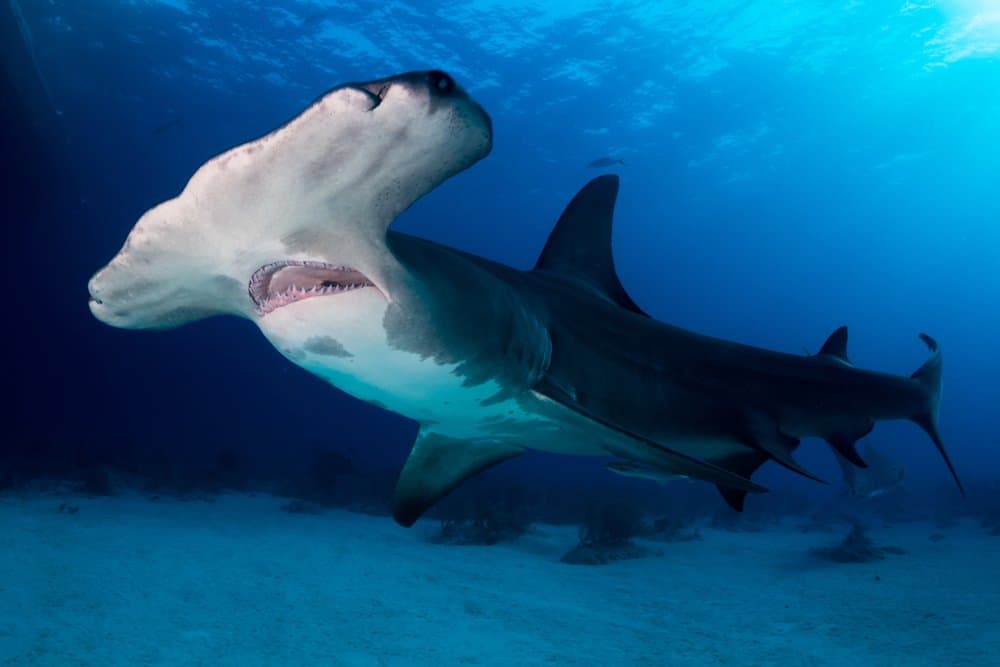
Hammerhead sharks are some of the strangest-looking creatures in the world.
©HakBak/Shutterstock.com
Appearance: Light grey with a greenish tint, white undersides, and “T” shaped heads with eyes on the end of their cephalofoils.
Size: 12-18 feet, with the females being larger. Maximum weight is 990 pounds.
Where to Avoid: Warmer, shallow water close to the beach or anywhere you see fish jumping out of the water or seals hanging out.
Unpleasant Symptoms: Loss of limb, fingers, toes, or possibly just a painful bite
Hammerhead sharks are the oddest looking sharks not on the bottom of the ocean. The goblin shark is a bit peculiar but is found much deeper than the typical shark. Hammerheads have the best eyesight and viewing range of any shark since their eyes are located at the end of their cephalofoils. The Hammerhead has binocular capabilities and high-quality depth perception. These sharks prefer warmer water and move south as the northern water becomes too cold. In the hot summer months along the Massachusetts coast, the hammerheads can be found in shallow, warm water.
4. Grey Seal (halichoerus grypus)
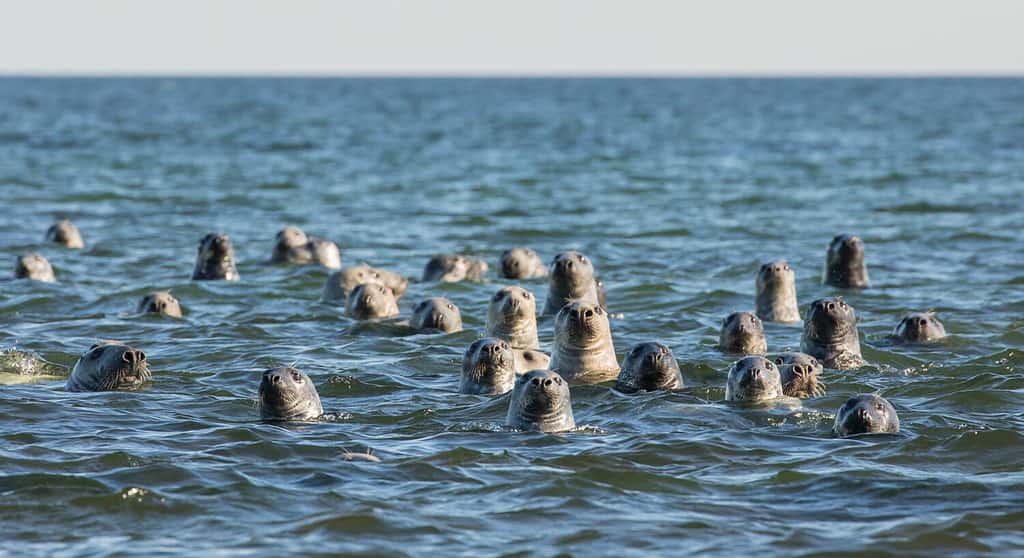
Grey seals are adorable and look like they might make great swimming buddies, but beware, they are the primary food source of sharks in the area.
©F-Focus by Mati Kose/Shutterstock.com
Appearance: Grey with back spots, large eyes, and fins
Size: 5.2-10.8 feet long
Where to Avoid: Steer clear of areas where seals are lingering.
Unpleasant Symptoms: Sharks dine primarily on seals, sometimes confusing us for them.
Grey seals are huge and adorable but should come with a warning label. They tend to be a favorite on the shark’s menu, and where there are seals, there are also sharks lurking in the water waiting for a meal. Many shark bites happen when a human is mistaken for a seal. These seals are excellent swimmers and can even swim to depths of almost 1000 feet while looking for food. They feed on shrimp, mollusks, squid, fish, and octopus.
5. Bottlenose Dolphins (Tursiops truncatus)

Despite their sweet appearance and lovable movies, dolphins can take play too far when it becomes cruelty.
©Elena Larina/Shutterstock.com
Appearance: Grey, black, and white with long noses
Size: 330-1430 pounds and up to 13 feet
Where to Avoid: The ocean at dawn and dusk, but it can happen any time of day.
Unpleasant Symptoms: They have been known to harass people, play too rough, and become aroused by it. They can be a bit pushy with their species and even humans. They don’t understand “no.”
Bottlenose dolphins are found all over the oceans and can live up to 60 years old. Females generally live about 20 years longer than males. There have been many reports of dolphins helping each other and also humans. Still, there are also many reports of primarily male dolphins hurting and killing calves, bullying other dolphins, forcibly mating with other dolphins, and sometimes doing so in groups. This behavior also happens when a dolphin may be playing, but they don’t know when to stop or not start at all. This behavior can also occur between dolphins and humans.
6. Portuguese Man O’ War Jellyfish (Physalia physalis)
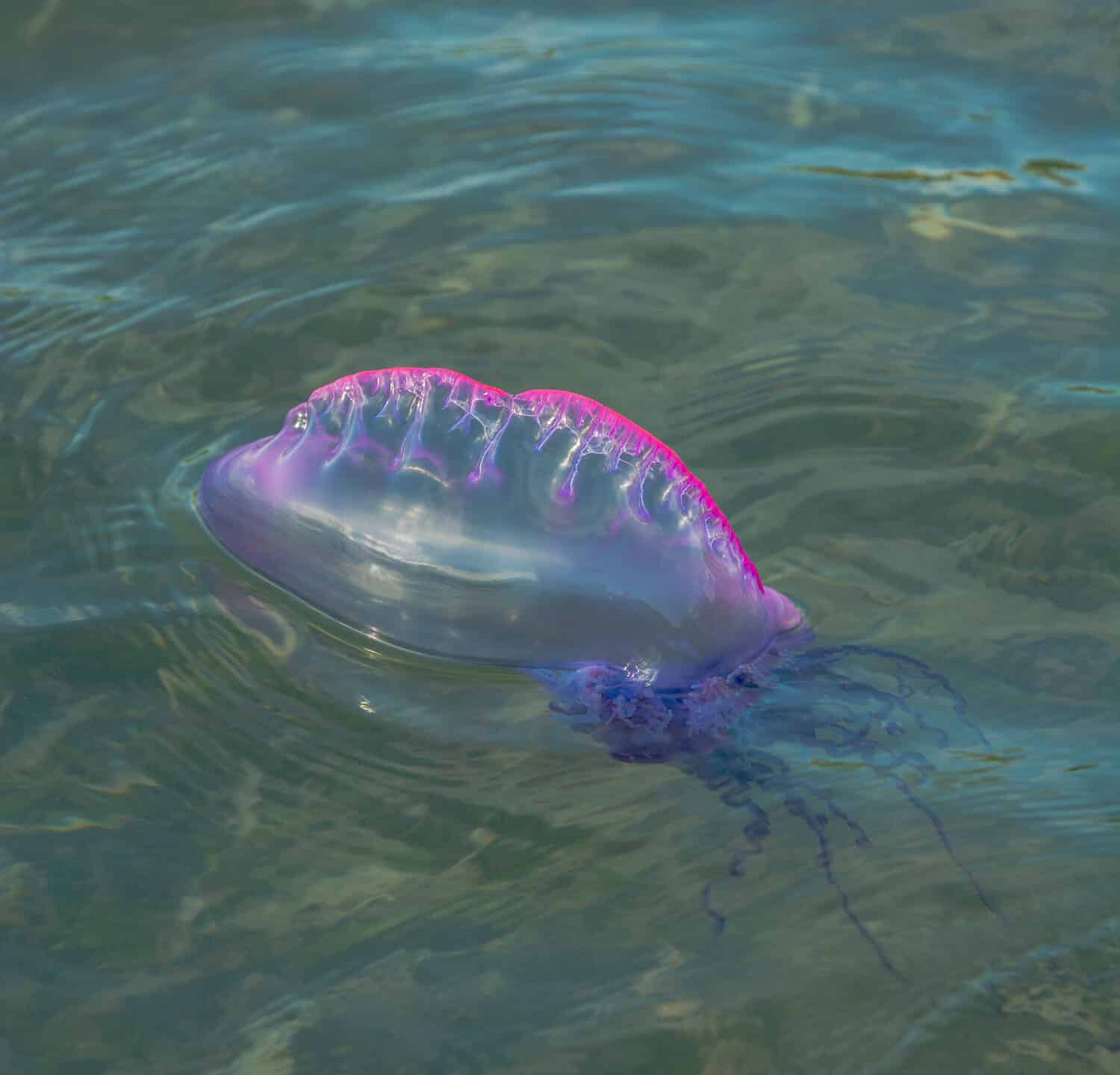
The Portuguese Man O’ War is not actually a
jellyfish
.
©Broadbelt/Shutterstock.com
Appearance: Strange electric blue and pinkish purple plastic bags with long danger strings floating all around them
Size: 12 inches long, 5 inches wide, and tentacles that can extend 165 feet but are generally an average of 30 feet.
Where to Avoid: Far out in the open ocean
Unpleasant Symptoms: Severe pain with welts where the tentacles touched the skin, burning, swelling, cramps, fever, sweating, weakness, dizziness, nausea, and diarrhea. The symptoms can persist for up to 6 weeks.
Portuguese Man O’ Wars are something you definitely want to avoid. No matter if you are minimally or severely stung, the stinging tentacle symptoms are not something you would be okay with experiencing while visiting the Massachusetts coast. These peaceful siphonophores, meaning they are made up of not one but four separate zooids working together, enjoy floating in the open ocean, searching for small fish. They float approximately six inches above the water and have sometimes been known to form huge groups in the sea of over 1000 Man O’ Wars. Some species of fish actually use the Man O’ War’s tentacles to protect themselves against predators and are immune to the sting.
7. Lion’s Mane Jellyfish (Cyanea capillata)

A Lion’s Mane Jellyfish is gigantic with tentacles reaching over 120 ft long.
©Ethan Daniels/Shutterstock.com
Appearance: Transulent brown to reddish color with a thick mane of long tendrils and a fluffy plume of brownish oral arms under their bell.
Size: 12-20 inches in diameter, with some specimens reaching 8 feet in diameter! Tentacles can reach 120 feet in length, and they can weigh as much as 200 pounds.
Where to Avoid: The surface of the ocean up to 66 feet below the surface
Unpleasant Symptoms: Red, inflamed stripes which can turn into blisters or wounds, along with pain, burning, and itching
The lion’s mane jellyfish is the largest jellyfish and prefers cooler water up north along the Massachusetts coast, but does tend to stay close to the ocean’s surface. They are very slow swimmers and depend on the current to send them in the right direction. Sometimes they end up near the beach because of this. Occasionally, they can be seen in large groups out in the open ocean due to the tides pushing them together. Despite being enormous and venomous, these giants only live for one year. They do not target or attack people on purpose.
8. Lionfish (Pterois volitans)
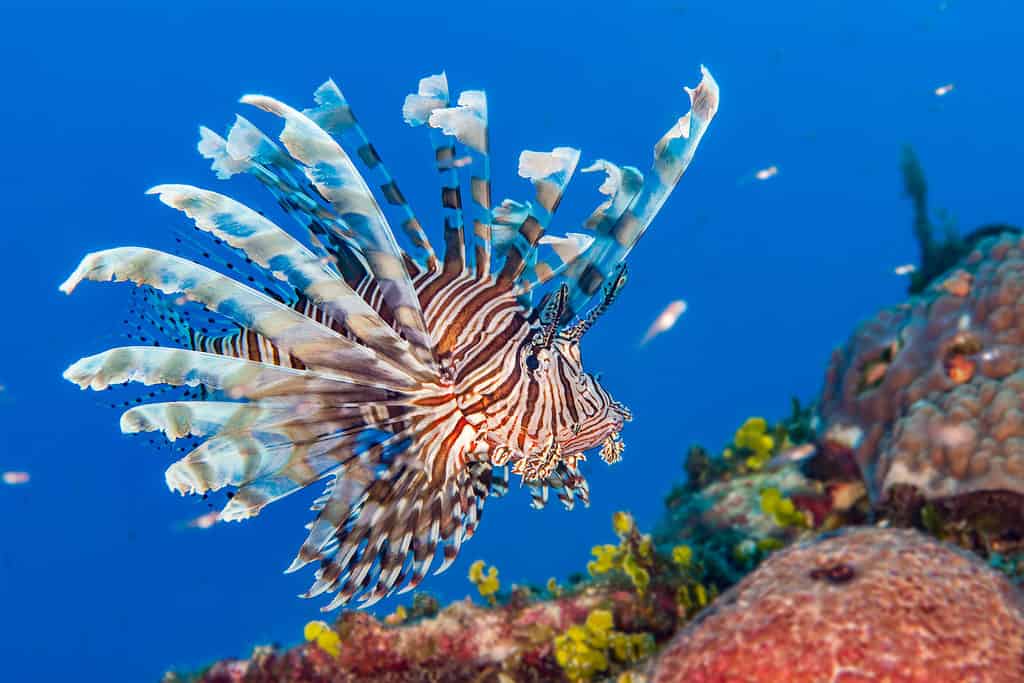
Lionfish fin rays are incredibly venomous and have earned them the title of one of the most dangerous fish in the ocean.
©bearacreative/Shutterstock.com
Appearance: Brown, red, black, orange, and white striped fish with long, feathery fins that surround it and long spines for stinging
Size: 12-14 inches long and 2.5 pounds
Where to Avoid: Rocky crevices at night
Unpleasant Symptoms: Pain, redness, and swelling or potentially more severe symptoms like paralysis, convulsions, nausea, headache, and numbness. Allergic reactions to the venom are relatively common, which creates significantly more severe side effects.
You will unlikely encounter a lionfish while swimming along the Massachusetts coast, but it can happen if the tide is right. The nocturnal lionfish prefers tropical waters and rocky substrate not deeper than 500 feet below the ocean’s surface. They are an invasive species now found all along the east coast of the United States. The lionfish is so intrusive that the public is asked to fish for and eat them. Word is that these fancy fish taste a bit like lobsters.
In the 1990s, divers spotted the invasive lionfish in the Atlantic Ocean, and since then, their numbers have exploded. One reason for this is that they can reproduce and lay eggs every few days for a lifetime of 20 years. They can lay up to two million eggs per year!
9. Great White Shark (Carcharodon carcharias)

Juvenile
Great White Sharks
have been filmed, in abundance, swimming close to humans, particularly surfers, and paddleboarders. An attack by a juvenile has never been reported.
©Vincent Legrand/Shutterstock.com
Appearance: Grey upper and white lower half, black eyes, large teeth, and mouth size
Size: 15-20 feet long
Where to Avoid: Anywhere that you see seals in or around the water
Unpleasant Symptoms: Loss of limbs, drowning, death
The great white shark gets a bad rap along the Massachusetts coast, and some of it is warranted because they tend to mistake people for seals occasionally. Several different kinds of seals grace the northern state’s coast, making their waters prime territory for great white sharks and plenty of other sharks who also love the taste of seals.
Fatalities are rare since sharks do not eat people unless starving to death. They much prefer seals for dinner but do not have very good eyesight. A test bite is generally what people experience when attacked by a shark. A test bite is not something anyone wants to experience, and that one bite could prove to be fatal. The smell of blood in the water will draw other sharks who may also attack, but it is generally the great white sharks that get blamed. This is likely due to the movie Jaws, filmed in Martha’s Vineyard in Massachusetts.
10. Humans (Homo sapiens)

Humans are, by far, the most hazardous and dangerous beings on the planet.
©Rich Carey/Shutterstock.com
Appearance: Spectrum of whites, tans, and blacks with varying shades of hair color and body size
Size: Up to 1000 pounds though generally average between 150-250 pounds and up to 7 feet tall
Where to Avoid: Literally everywhere
Unpleasant Symptoms: They cause pollution, sludge, and bacterial infestations in the water, and leave fish hooks, trash, broken glass, and cigarettes behind in the water and on the beach, which causes a slow death for all marine life
Humans are the worst and most dangerous beings on the Massachusetts coast. They are hazardous to flora, fauna, and even themselves. The primary danger along the Massachusetts coast is the toxic sludge dumped into the ocean via pipes. This sludge is no other than human excrement. The bacteria level will be so high from humans that “no swimming” signs are displayed so other humans do not swim in it and become sick or die. Not all of us are bad, but many are either ignorant or uncaring enough to allow this and other manmade problems to exist and threaten the beautiful Massachusetts coast.
Fun Facts
- The grey seal’s name in Latin, “Halichoerus grypus” means “hook-nosed sea pig.”
- A great white shark can eat an entire seal and not eat again for three months!
- The hammerhead shark can live up to 30 years of age.
- In Japan and elsewhere, sea urchins are captured for their eggs, called roe, which is a delicacy.
- Box jellyfish have 24 eyes giving them 360-degree vision.
- Juvenile great white sharks like to swim near surfers and paddleboarders, and there has never been a reported attack.
- Bottlenosed dolphins can live up to 60 years.
- A male false killer whale and a female bottlenose dolphin can mate and produce wholphins.
- The largest great white shark, Deep Blue, was found off the coast of Mexico. It was 20 feet long and possibly 50 years old.
- Jellyfish have very short lives. Some only live a few hours, and at most other larger jellyfish only live a few years.
- Lionfish venom contains neurotoxins and neurotransmitters causing muscle spasms, high heart rate, and dizziness.
Summary of the 10 Most Dangerous Animals Found in Massachusetts’s Oceans
Here are the 10 Most Dangerous Animals Found in Massachusetts’s Oceans:
| Rank | Dangerous Animals |
|---|---|
| 1 | Green Sea Urchin (Strongylocentrotus droebachiensis) |
| 2 | Acorn Barnacle (Semibalanus balanoides) |
| 3 | Hammerhead Shark (Sphyrna Zygaena) |
| 4 | Grey Seal (halichoerus grypus) |
| 5 | Bottlenose Dolphins (Tursiops truncatus) |
| 6 | Portuguese Man O’ War Jellyfish (Physalia physalis) |
| 7 | Lion’s Mane Jellyfish (Cyanea capillata) |
| 8 | Lionfish (Pterois volitans) |
| 9 | Great White Shark (Carcharodon carcharias) |
| 10 | Humans (Homo sapiens) |
The photo featured at the top of this post is © Sergey Uryadnikov/Shutterstock.com
Thank you for reading! Have some feedback for us? Contact the AZ Animals editorial team.






